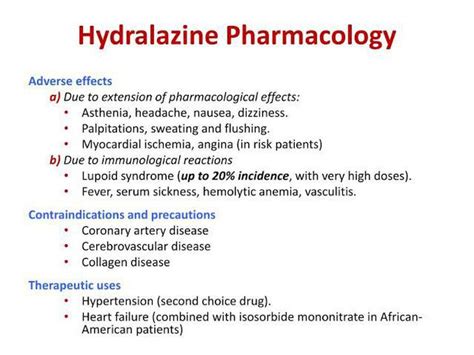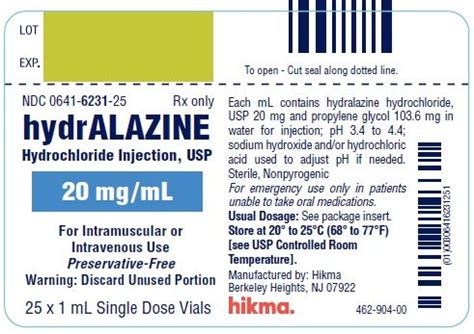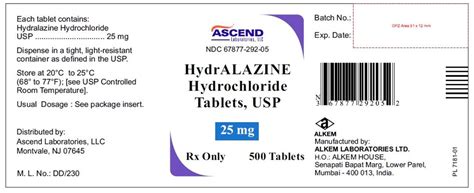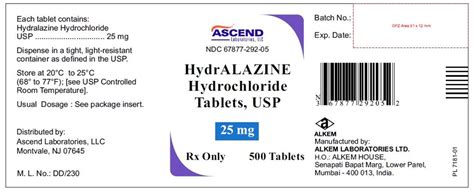Intro
Discover the potential Hydralazine side effects, including hypotension, tachycardia, and lupus-like symptoms, and learn how to manage them with proper medication and dosage.
Hydralazine is a medication that has been used for decades to treat high blood pressure and heart failure. It belongs to a class of drugs known as vasodilators, which work by relaxing and widening blood vessels to improve blood flow and reduce blood pressure. While hydralazine can be an effective treatment for certain cardiovascular conditions, it can also cause a range of side effects, some of which can be serious.
The importance of understanding the potential side effects of hydralazine cannot be overstated. Patients who are taking this medication need to be aware of the possible risks and benefits, so they can make informed decisions about their treatment and seek medical attention if they experience any adverse effects. Additionally, healthcare providers need to carefully monitor patients who are taking hydralazine and adjust their treatment plans as needed to minimize the risk of side effects.
Hydralazine is often used in combination with other medications to treat high blood pressure and heart failure. It can be prescribed as a tablet or injection, and the dosage and frequency of administration will depend on the individual patient's needs and medical condition. While hydralazine can be an effective treatment for certain cardiovascular conditions, it is not without risks. Patients who are taking this medication need to be aware of the possible side effects and take steps to minimize their risk.
Common Side Effects of Hydralazine

Less Common Side Effects of Hydralazine
Less common side effects of hydralazine include joint pain, muscle pain, and tingling or numbness in the hands and feet. Some patients may also experience changes in their sense of taste or smell, or they may develop a rash or itching sensation on their skin. In rare cases, hydralazine can cause more serious side effects, such as anemia, kidney failure, or a condition called vasculitis, which is characterized by inflammation of the blood vessels.Serious Side Effects of Hydralazine

Hydralazine and Pregnancy
Women who are pregnant or breastfeeding should use hydralazine with caution. Hydralazine can cross the placenta and may affect the developing fetus, and it can also be excreted in breast milk and may affect the nursing infant. Women who are pregnant or breastfeeding should discuss the potential risks and benefits of hydralazine with their healthcare provider and use the medication only under close medical supervision.Interactions with Other Medications

Managing Side Effects of Hydralazine
Patients who experience side effects while taking hydralazine should inform their healthcare provider. In some cases, the healthcare provider may be able to adjust the dosage or frequency of administration to minimize the risk of side effects. Patients can also take steps to manage side effects, such as taking hydralazine with food to reduce the risk of nausea and vomiting, or changing positions slowly to reduce the risk of dizziness and lightheadedness.Long-Term Use of Hydralazine

Alternatives to Hydralazine
Patients who experience side effects while taking hydralazine may want to consider alternative treatments. There are several other medications that can be used to treat high blood pressure and heart failure, including beta blockers, ACE inhibitors, and calcium channel blockers. Patients should discuss the potential benefits and risks of these alternative treatments with their healthcare provider and choose the treatment that is best for their individual needs and medical condition.Conclusion and Future Directions

Final Thoughts
Patients who are taking hydralazine should work closely with their healthcare provider to manage their treatment and minimize their risk of side effects. By being aware of the potential risks and benefits of hydralazine and taking steps to manage side effects, patients can get the most out of their treatment and improve their overall health and well-being.What are the most common side effects of hydralazine?
+The most common side effects of hydralazine include headache, dizziness, and nausea. Other common side effects include rapid heartbeat, palpitations, and swelling in the feet and ankles.
Can hydralazine cause serious side effects?
+Yes, hydralazine can cause serious side effects, including lupus-like syndrome, kidney problems, and blood disorders. Patients who experience any of these side effects should seek medical attention immediately.
How can I minimize my risk of side effects while taking hydralazine?
+Patient can minimize their risk of side effects by taking hydralazine as directed, informing their healthcare provider about all the medications they are taking, and reporting any side effects promptly.
